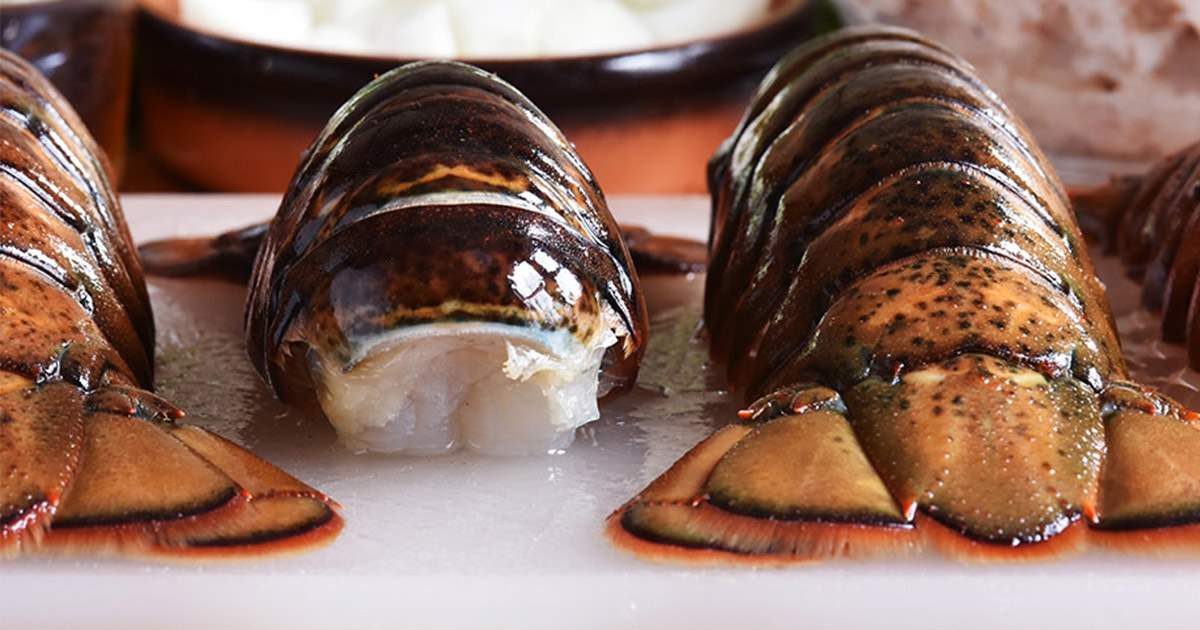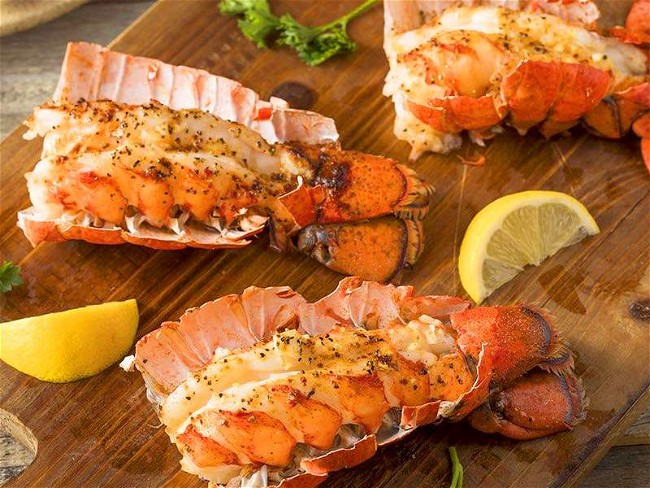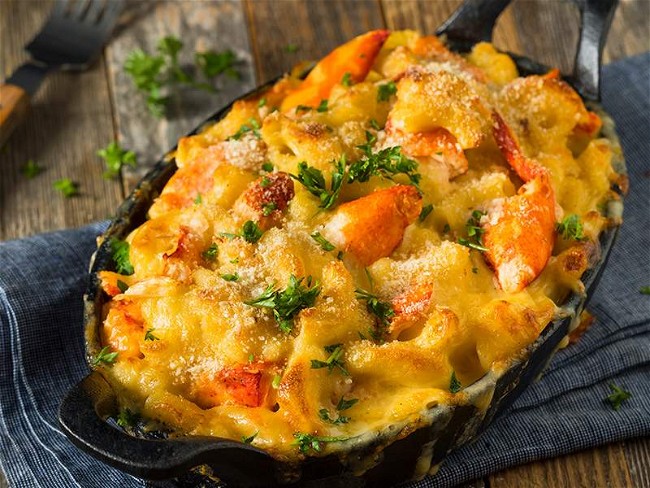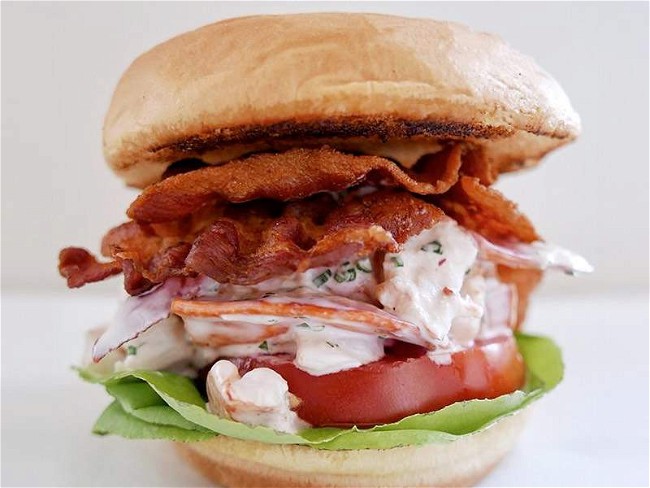Your Essential Guide to Lobster

Lobster – the word alone conjures images of celebration, luxury, and seaside feasts. This celebrated crustacean, however, has a fascinating journey from humble beginnings to becoming the crown jewel of seafood dining.
Lobster wasn't always expensive nor cherished for dishes like lobster rolls. "In colonial times, lobsters were so abundant they were used for fertilizer and fed to prisoners," explains Robert DiGregorio, who has spent decades handling lobsters as Fulton Fish Market’s head of quality control. "Even as late as the 1880s, lobster was still so common it was used as bait for cod and striped bass."
In the late 19th and early 20th centuries, lobster transformed into a luxury item as lobster fishing got more regulated and new refrigerated transportation allowed lobster to reach inland markets, where it was perceived as exotic.
"We are truly fortunate to have the American lobster, one of the most delicious creatures to live in the sea, right on our doorstep," DiGregorio shared.
In this guide, you will learn what makes lobster meat so special, when lobster seasons are, how to tell different species apart, and more to make your next lobster dinner a truly special occasion. This guide covers everything you need to know about this delicious seafood. Let’s dig in!
- What is Lobster?
- What Does Lobster Taste Like?
- Types of Lobster
- How Are Lobsters Harvested?
- Is Lobster Sustainable?
- What Goes Well With Lobster?
What is Lobster?
Lobsters are decapod crustaceans, considered shellfish, belonging to the family Nephropidae. They're characterized by their hard exoskeleton, 10 legs (including their distinctive claws), and long antennae. While there are numerous species worldwide, the most commonly referred to species is the American lobster (Homarus americanus).
Boiling is the most popular method for cooking a lobster. Lobster can also be grilled, steamed, poached, and broiled to reach a perfect cook. For more information on cooking lobsters, check out our blog on the best ways to cook whole lobster.
What Does Lobster Taste Like?
Lobster meat is known for its sweet, delicate flavor and tender yet slightly firm texture. The taste of cooked lobster meat is often described as a perfect blend of sweet and briny notes that embody the essence of the ocean.
"The meat is clean and salty-sweet, and is almost crisp in texture, what chefs call 'a good chew,'" describes DiGregorio. "You should also try the tomalley–the green part commonly called the liver. It is a true delicacy."
Like most other seafood species, lobsters get their wonderful flavors from their own diets. Lobsters eat small fish, mollusks, other crustaceans, worms, and some plant matter. Once caught or held in tanks, lobsters are often fed fish scraps and specially formulated feeds to maintain their health and flavor.
Types of Lobster
Lobster species each have unique characteristics that influence not just their appearance, but their flavor profiles and culinary applications. Each lobster species and fishery region has its own season, too. Here are the most common lobster species you may find in the US.
- American lobster (Homarus americanus) is the most prized lobster. Known for its large, meaty claws, the American lobster has a dark greenish-brown shell that turns red when cooked. Thriving in cold Atlantic waters from Labrador to North Carolina, especially along the Maine coast, its meat offers a sweet, clean flavor with delicate brininess. American lobster seasons vary by region, with Maine lobster season peaking from June through September.
- Rock lobster (Panulirus species), is also called spiny lobster. These lobsters lack front claws, boast long, spiny antennae, and a vibrant reddish-brown shell adorned with white spots. Found in warmer waters worldwide, these lobsters offer sweet, firm tail meat that's slightly more robust in flavor than clawed varieties, with a unique texture that holds up beautifully to grilling. In the US, spiny lobsters are commonly caught in Florida and California. The lobster season in Florida runs primarily from August through March and California spiny lobster season runs from October through March.
-
European lobster (Homarus gammarus) has a stunning cobalt-blue shell with yellowish undertones that transforms to the familiar bright red when cooked. Typically smaller than its American cousin but with proportionally larger claws, these lobsters inhabit rocky coastal waters from Norway to North Africa, including the Mediterranean Sea. European lobsters share a sweet, delicate flavor and firm texture with American lobsters. The primary harvesting season for European lobster runs from late spring through early autumn.
How Are Lobsters Harvested?
Most lobsters are harvested from the wild with traps, also called pots. These traps are large enough to contain lobsters yet small enough to let other marine life escape. Lobster fishers, or lobstermen or lobsterwomen, put bait in the traps before dropping them to the ocean floor. After a few hours or overnight, the traps are hauled aboard for the crew to measure each lobster by hand. Any undersized lobsters or egg-bearing females are promptly returned to the ocean to support sustainable populations. The harvested lobsters are then kept alive in tanks from sea to market, and ultimately, your kitchen.
In addition to trapping, lobsters may also be harvested by less common methods such as trawling with nets or having divers fetch the lobsters by hand. All forms of lobster harvest in the US are strictly regulated by each state and NOAA Fisheries.
Langoustine vs Lobster: What’s The Difference?
Langoustines and lobsters share similarities in taste, but are not related to one another. Langoustines, also known as Norway Lobsters and Dublin Bay Prawns, are orange-pinkish crustaceans resembling small lobsters. Langoustines typically grow to about 10 inches long and 3oz in weight, compared to American lobsters at 1-2 feet long and over a pound.
Langoustines have slender bodies and long pincers, with most of their meat coming from their long and narrow tails. Their popularity has surged among chefs and home cooks for their sweet, elegant, and complex taste. Langoustines can be found in the Northeastern Atlantic Ocean, the North Sea, and the Northern Adriatic Sea.
It's important to note that langoustines are not the same as langostinos. Langostinos, a type of squat lobster, are more closely related to crabs than lobsters. Langostinos are usually sold as tail meat, resembling small cooked shrimp, and don’t share the prized taste and texture found in langoustine meat.
Is Lobster Farmed or Wild Caught?
Unlike other seafoods, lobster farming faces significant challenges and remains relatively undeveloped. Lobsters grow slowly, taking 5-7 years to reach one pound, and tend to cannibalize each other, making it difficult to raise them together. Lobster also has a poor feed conversion ratio, meaning it takes significant feed to develop a pound of lobster meat. Experimental aquaculture operations focus on raising juvenile lobsters for release into the wild rather than growing them to market size. Some smaller operations will "fatten" wild-caught lobsters in controlled environments before selling them, but this isn't traditional farming.
Is Lobster Sustainable?
Lobsters in the US and Canada are considered sustainable if fishermen follow the strict government regulations to ensure long-term conservation. Permits are required to catch lobsters, and there are restrictions on the size and sex of the lobsters. Females carrying eggs cannot be taken and are immediately released back into the water. All traps must have escape vents, and lobster boats must submit vessel trip reports detailing their fishing activities to maintain healthy lobster populations. At Fulton Fish Market, we’re proud to source our lobster only from the most trusted producers in North America to ensure lobster sustainability for future generations.
Is Lobster Healthy?
Lobster offers numerous nutritional benefits, making it a valuable addition to a balanced diet. It is a great source of protein, low in calories, and ideal for diets from keto to Whole30. A single 4oz (113g) serving of lobster meat holds approximately 90 calories, 19 grams of protein, 0 grams of fat, and 0 grams of carbohydrates. It also provides high amounts of omega-3 fatty acids, vitamin B12, zinc, copper, selenium, and phosphorus.
What Goes Well With Lobster?
Lobster's sweet, delicate flavor pairs beautifully with a range of complementary flavors and sides.
Traditional Lobster Accompaniments
- Melted butter: The classic pairing that enhances lobster's natural sweetness.
- Lemon: A squeeze of fresh lemon brightens and balances the richness.
- Herbs: Tarragon, chives, and parsley complement lobster without overpowering the meat.
Side Dishes For Lobster
- Steak: “Surf and Turf” has been a popular protein combination since the 1960s, pairing up lobster and steak for a balanced, celebratory dish. Surf and turf brings steak’s richness and earthiness to the plate, perfectly complementing the sweetness and firmness of lobster meat.
- Corn on the cob: A classic New England pairing that matches sweetness with sweetness.
- Potatoes: Whether roasted, mashed, or as potato salad, potatoes provide a satisfying counterpoint.
- Light salads: Crisp greens with a simple vinaigrette offer a refreshing contrast.
- Crusty bread: Perfect for soaking up buttery, lobster-infused sauces.
Wine Pairings For Lobster
- Chardonnay: Particularly unoaked varieties that won't overpower the delicate flavor.
- Champagne or sparkling wine: The effervescence cuts through rich butter sauces.
- Sauvignon Blanc: Crisp acidity complements the lobster's sweetness.
- Pinot Grigio: Light, refreshing, and won't compete with the star of the show.
Our Favorite Lobster Recipes
Easy Broiled Lobster Tails Recipe
Learn to cook lobster tails in just 20 minutes! They couldn't be easier to make, and once you've mastered our easy lobster tail recipe, you'll love trying it with other seasonings and flavored oils (we love lemon or chili-infused olive oil).
Slow Cooker Lobster Mac and Cheese Recipe
Here’s an instant classic easily prepared in a slow cooker with our cooked American lobster meat. Tender pasta, sweet knuckle and claw meat, and three (yes, three!) cheeses meld into an indulgent “heaven in a bowl.”
What’s better than lobster rolls? Perhaps lobster rolls with lots of bacon! This over-the-top recipe starts with a lemony mayonnaise that brings out the sweet flavor of the lobster, which you add to the rolls after tossing the lobster with butter and adding crumbled bacon. Lining the rolls with lettuce adds additional crunch to this drool-worthy sandwich.
FAQs
Why Is Lobster So Expensive?
Lobster's premium price is influenced by several factors, from growth rate to transportation challenges. Lobsters grow slowly, taking 5-7 years to reach market size, which limits how many can be harvested in a given year. Distribution costs are also high since specialized transportation is needed to keep lobsters alive and healthy. Lastly, seasonal holiday demand can increase lobster prices due to limited supply and increased demand.
Why are some Maine lobsters blue?
About 1 American lobster out of every 2 million have a striking blue shell due to a rare pigment disorder. While they are otherwise the exact same as your typical lobster, the rarity of the blue lobster makes it a stunning specimen. Even rarer than the blue lobster is the calico lobster–about 1 in every 30 million. In decades at Fulton Fish Market, DiGregorio has only seen 2 calico lobsters, which have a remarkable multicolored shell of orange, yellow, and more.
Can You Eat Raw Lobster?
Although occasionally served in raw preparations like sushi, lobster is typically not recommended to be eaten raw. Thoroughly cooking lobster will reduce the risks of consuming bacteria and parasites that can cause foodborne illness. These pathogens are killed during the cooking process, making cooked lobster the safest to eat.
The texture and flavor of lobster are also significantly improved by cooking. Raw lobster meat tends to be gelatinous and lacking flavor qualities, while proper cooking transforms it into the tender, sweet delicacy we all enjoy.
How Long Can a Lobster Live?
Lobsters are among the longest-lived sea creatures, with lifespans of 50+ years. Their slow growth rate and periodic shell shedding make it challenging for scientists to estimate their age accurately. Lobsters also show negligible senescence, meaning they don't age in the traditional sense, so they are believed to never stop growing and can reproduce throughout their lives.
Can You Eat Lobster While Pregnant?
Yes, lobster is generally safe for pregnant women when properly cooked. The American Pregnancy Association and the FDA include lobster among recommended seafood options during pregnancy due to its low mercury content and dense nutritional benefits, including omega-3 fatty acids. Pregnant women should ensure lobster is sourced from a reliable producer and thoroughly cooked to eliminate potential health risks.
How Do You Kill A Lobster?
Before cooking, many chefs and home cooks prefer to dispatch lobsters humanely. To quickly kill a lobster, the most popular method is to quickly split the lobster’s head down the center with a sharp knife, starting an inch or so behind the eyes. This will quickly stop all nervous function in the lobster.
Video courtesy of Chef Tway Nguyen, @Twaydabae



